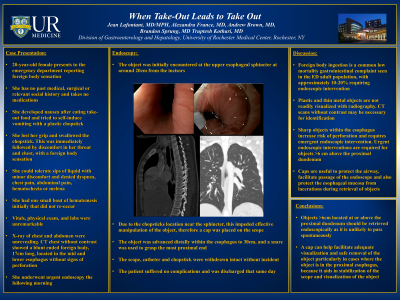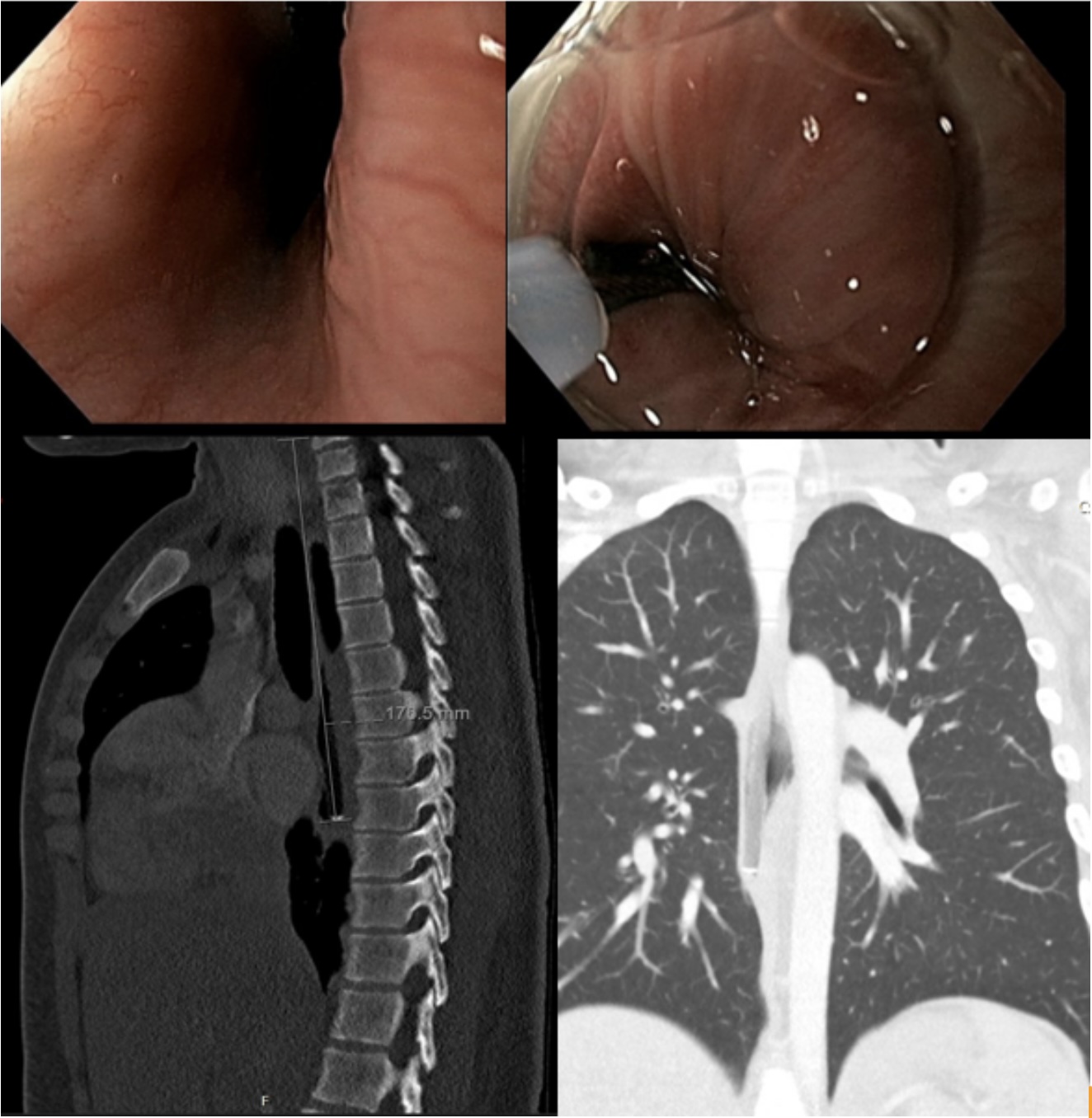Monday Poster Session
Category: General Endoscopy
P2438 - When Take-Out Leads to Take Out
Monday, October 28, 2024
10:30 AM - 4:00 PM ET
Location: Exhibit Hall E

Has Audio
- JL
Jean Lafontant, MD, MPH
University of Rochester Medical Center
Rochester, NY
Presenting Author(s)
Jean Lafontant, MD, MPH, Alexandra France, MD, Andrew Brown, MD, Brandon Sprung, MD, Truptesh Kothari, MD
University of Rochester Medical Center, Rochester, NY
Introduction: Foreign body ingestion is a common GI complaint seen in emergency rooms, with approximately 10-20% requiring endoscopic intervention. Adults with psychiatric illnesses, the incarcerated, edentulous and/or intoxicated are most at risk. Plastic and thin metal objects are not readily visualized with radiography, and CT scans without contrast may be necessary for identification. Sharp objects within the esophagus increase risk of perforation and require emergent endoscopic intervention. Urgent endoscopic interventions are required for objects >6 cm above the proximal duodenum utilizing varied retrieval devices.
Case Description/Methods: A healthy 20-year-old female presents to the emergency department reporting foreign body sensation. She developed nausea after eating take-out food and tried to self-induce vomiting with a plastic chopstick. While holding the chopstick in her oropharynx, she felt on the verge of vomiting, lost her grip and swallowed the chopstick. She immediately felt discomfort in her throat and chest, with foreign body sensation. She could tolerate sips of liquid with minor discomfort and denied dyspnea, chest pain and abdominal pain. Vitals, physical exam, and labs were unremarkable. X-ray of chest and abdomen were unrevealing. CT chest showed a blunt ended foreign body, 17cm long, located in the mid and lower esophagus without signs of perforation. She underwent urgent endoscopy the next morning.
The chopstick was encountered at the upper esophageal sphincter (UES) at 20cm from the incisors. Due to its location near the sphincter, it was difficult to manipulate. Therefore, a cap was placed on the scope, the object advanced distally within the esophagus to 30cm, and a snare was used to grasp the most proximal end of the object. The scope, catheter and object were withdrawn intact without incident. The object was confirmed to be a chopstick. The patient suffered no complications and was discharged that same day.
Discussion: Society guidelines recommend any object >6cm located at or above proximal duodenum be retrieved endoscopically as it is unlikely to pass spontaneously. Using a snare or basket to grasp the object can be helpful especially in the case of larger objects which can be challenging to remove. A cap can help facilitate adequate visualization and safe removal of the object. The cap is particularly helpful in cases like this, where the object is in the proximal esophagus, near the UES, because it aids in stabilization of the scope and visualization of the object.

Disclosures:
Jean Lafontant, MD, MPH, Alexandra France, MD, Andrew Brown, MD, Brandon Sprung, MD, Truptesh Kothari, MD. P2438 - When Take-Out Leads to Take Out, ACG 2024 Annual Scientific Meeting Abstracts. Philadelphia, PA: American College of Gastroenterology.
University of Rochester Medical Center, Rochester, NY
Introduction: Foreign body ingestion is a common GI complaint seen in emergency rooms, with approximately 10-20% requiring endoscopic intervention. Adults with psychiatric illnesses, the incarcerated, edentulous and/or intoxicated are most at risk. Plastic and thin metal objects are not readily visualized with radiography, and CT scans without contrast may be necessary for identification. Sharp objects within the esophagus increase risk of perforation and require emergent endoscopic intervention. Urgent endoscopic interventions are required for objects >6 cm above the proximal duodenum utilizing varied retrieval devices.
Case Description/Methods: A healthy 20-year-old female presents to the emergency department reporting foreign body sensation. She developed nausea after eating take-out food and tried to self-induce vomiting with a plastic chopstick. While holding the chopstick in her oropharynx, she felt on the verge of vomiting, lost her grip and swallowed the chopstick. She immediately felt discomfort in her throat and chest, with foreign body sensation. She could tolerate sips of liquid with minor discomfort and denied dyspnea, chest pain and abdominal pain. Vitals, physical exam, and labs were unremarkable. X-ray of chest and abdomen were unrevealing. CT chest showed a blunt ended foreign body, 17cm long, located in the mid and lower esophagus without signs of perforation. She underwent urgent endoscopy the next morning.
The chopstick was encountered at the upper esophageal sphincter (UES) at 20cm from the incisors. Due to its location near the sphincter, it was difficult to manipulate. Therefore, a cap was placed on the scope, the object advanced distally within the esophagus to 30cm, and a snare was used to grasp the most proximal end of the object. The scope, catheter and object were withdrawn intact without incident. The object was confirmed to be a chopstick. The patient suffered no complications and was discharged that same day.
Discussion: Society guidelines recommend any object >6cm located at or above proximal duodenum be retrieved endoscopically as it is unlikely to pass spontaneously. Using a snare or basket to grasp the object can be helpful especially in the case of larger objects which can be challenging to remove. A cap can help facilitate adequate visualization and safe removal of the object. The cap is particularly helpful in cases like this, where the object is in the proximal esophagus, near the UES, because it aids in stabilization of the scope and visualization of the object.

Figure: Endoscopic and CT Visualization of Chopstick
Disclosures:
Jean Lafontant indicated no relevant financial relationships.
Alexandra France indicated no relevant financial relationships.
Andrew Brown indicated no relevant financial relationships.
Brandon Sprung indicated no relevant financial relationships.
Truptesh Kothari indicated no relevant financial relationships.
Jean Lafontant, MD, MPH, Alexandra France, MD, Andrew Brown, MD, Brandon Sprung, MD, Truptesh Kothari, MD. P2438 - When Take-Out Leads to Take Out, ACG 2024 Annual Scientific Meeting Abstracts. Philadelphia, PA: American College of Gastroenterology.
